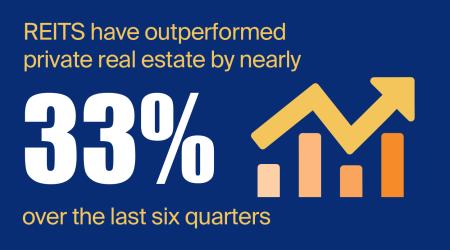
Mid-Year Report: Key Themes for the Second Half of 2024
As we look ahead to the second half of 2024, the economic and commercial real estate (CRE) environment will be shaped by the higher interest rate environment, expectations around when the Federal Reserve may begin easing monetary policy, and the continued rapid digitalization of economic activity.

Our outlook for CRE and REITs in the second half of the year highlights four key themes:
- REIT operational performance has been solid. High absolute and relative occupancy rates in the face of supply-demand imbalances showcase REITs’ prowess in asset selection and management.
- Disciplined balance sheets are enabling REITs to enjoy greater operational flexibility and face less stress than their counterparts with higher debt loads and costs.
- Public real estate outperformance continues. On a cumulative total return basis, public real estate has outperformed its private market counterpart by nearly 33% over the last six quarters. Despite this outperformance, the public-private valuation divergence also continues. With capitalization (cap) rate spreads remaining wide, there is likely more fuel in the tank for REIT outperformance in 2024.
- REIT occupancy rate and pricing advantages have combined to suggest that REITs offer more for less and present an opportunity for real estate investors.
The start of the third quarter of 2024 marks roughly two years of divergence between REIT and private real estate valuations. While the valuation gap is slowly closing, this extended adjustment period continues to offer an attractive entry point for institutional investors to add REITs to their real estate strategies.
Over the past year, Nareit has published several case studies demonstrating how REITs have been leaders in providing access to new and emerging property sectors, global real estate, and best-in-class sustainability performance—and how these attributes are driving institutional investors to increasingly use REITs to "complete" their real estate portfolios. (Read more about how the Teacher Retirement System of Texas, the Employees Retirement System of Texas, and CenterSquare Investment Management each approached adding REITs to their portfolios.)
In this mid-year report, we examine how the investment strategies for large, actively managed, dedicated REIT funds have evolved. The analysis shows that REIT managers have increasingly shifted their exposures to capture new and emerging sectors, while maintaining overweight positions in industrial and residential sectors.
Like in the United States, REIT and listed real estate returns around the globe are reflecting the prospect of higher interest rates. The performance of the countries, regions, and sectors underlying the FTSE EPRA Nareit Global Real Estate Index Series do not behave uniformly. Our review of global listed real estate returns highlights these important differences, which can provide investors with important diversification opportunities.
Listen to John Worth discuss the 2024 Mid-Year Report on this episode of the REIT Report Podcast.
Subscribe to the podcast on your listening platform of choice.